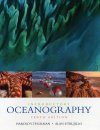Textbook
Edited By: Harold V Thurman and Elizabeth A Burton
544 pages, Col photos, illus, figs, tabs, maps
![Introductory Oceanography Introductory Oceanography]()
Click to have a closer look
About this book
Contents
Customer reviews
Biography
Related titles
About this book
Covers the fundamentals of marine origins, geological and physical properties of the oceans, water chemistry, and marine life, with an ecological rather than taxonomic coverage of organisms.
Contents
(NOTE: Each chapter opens with 'Key Questions' and concludes with a 'Chapter in Review' section, 'Key Terms,' 'Questions and Exercises,' and an 'Oceanography on the Web' section.) Introduction. What Is Oceanography? Earth's Oceans. Rational Use of Technology? The Nature of Scientific Inquiry. 1. Planet Ocean: A Historical Perspective. Geography of the Oceans. Early Exploration of the Seas. The Beginnings of Ocean Science. Twentieth Century Oceanography and Beyond. A Human Presence in the Ocean. 2. Origins: Beginnings of the Universe, Earth, and Life. Origin of the Universe. Origin of the Solar System and Earth. Rocks and Minerals. Origin of the Atmosphere and the Oceans. Cycling and Mass Balance. Origin of Life. Radiometric Dating and the Geologic Time Scale. 3. Plate Tectonics and the Ocean Floor. Evidence for Continental Drift. Evidence for Plate Tectonics. Earth Structure. Plate Boundaries. Testing the Model: Some Applications of Plate Tectonics. Plate Tectonics...To Be Continued. 4. Marine Provinces. Bathymetry. The Hypsographic Curve. Provinces of the Ocean Floor. 5. Marine Sediments. Lithogenous Sediment. Biogenous Sediment. Hydrogenous Sediment. Cosmogenous Sediment. Mixtures. Distribution of Neritic and Pelagic Deposits: A Summary. 6. Water and Seawater. Atomic Structure. The Water Molecule. Water's Thermal Properties. Water Density. Seawater. Dissolved Components Added and Removed from Seawater. Dissolved Gases in Seawater. Acidity and Alkalinity of Seawater. Processes Affecting Seawater Salinity. Surface and Depth Salinity Variation. Seawater Density. Comparing Pure Water and Seawater. 7. Air-Sea Interaction. Uneven Solar Heating on Earth. The Coriolis Effect. Atmospheric Circulation Cells on a Spinning Earth. The Oceans, Weather, and Climate. Sea Ice. Icebergs. The Atmosphere's Greenhouse Effect. 8. Ocean Circulation. Measuring Ocean Currents. Surface Currents. Upwelling and Downwelling. Surface Currents of the Oceans. Deep Currents. 9. Waves and Water Dynamics. What Causes Waves? How Waves Move. Wave Characteristics. Wind-Generated Waves. Tsunami. 10. Tides. Generating Tides. Tides in the Ocean. 11. The Coast: Beaches and Shoreline Processes. The Coastal Region. Erosional- and Depositional-Type Shores. Emerging and Submerging Shorelines. Characteristics of U.S. Coasts. Hard Stabilization. 12. Coastal Waters and Marginal Seas. Coastal Water Circulation. Estuaries. Coastal Wetlands. Lagoons. Marginal Seas. 13. The Marine Habitat. Classification of Living Things. Classification of Marine Organisms. Distribution of Life in the Oceans. Adaptations of Organisms to the Marine Environment. Divisions of the Marine Environment. 14. Biological Productivity and Energy Transfer. Primary Productivity. Photosynthetic Marine Organisms. Regional Productivity. Energy Flow. Biogeochemical Cycling. Tropic Levels and Biomass Pyramids. 15. Animals of the Pelagic Environment. Staying above the Ocean Floor. Adaptations for Seeking Prey. Adaptations to Avoid Being Prey. Marine Mammals. 16. Animals of the Benthic Environment. Rocky Shores. Sediment-Covered Shores. Shallow Offshore Ocean Floor. The Deep-Ocean Floor. 17. Marine Resources. Laws and Regulations. Ecosystems and Fisheries. Mariculture. Energy Resources. Geologic Resources. Chemical Resources. 18. Marine Environmental Concerns. What Is Pollution? Main Types of Marine Pollution. Other Concerns. Current Laws Governing Marine Pollution. Afterward. Appendix I: Metric and English Units Compared. Appendix II: Geographic Locations. Appendix III: Latitude and Longitude on Earth. Appendix IV: A Chemical Background: Why Water Has 2 H's and 1 O. Appendix V: Careers in Oceanography. Appendix VI: Taxonomic Classification of Common Marine Organisms. Glossary. Index.
Customer Reviews
Biography
Harold V. Thurman. Hal Thurman retired in May 1994, after 24 years of teaching in the Earth Sciences Department of Mt. San Antonio College in Walnut, California. Interest in geology led to a bachelor's degree from Oklahoma A & M University, followed by seven years working as a petroleum geologist, mainly in the Gulf of Mexico, where his interest in the oceans developed. He earned a master's degree from California State University at Los Angeles and then joined the Earth Sciences faculty at Mt. San Antonio College. Other books that Hal has coauthored include Essentials of Oceanography (with Alan Trujillo) and a marine biology textbook. He has also written articles on the Pacific, Atlantic, Indian, and Arctic Oceans for the 1994 edition of World Book Encyclopedia and served as a consultant on the National Geographic publication, Realms of the Sea. He still enjoys going to sea on vacations with his wife Iantha. Alan P. Trujillo. Al Trujillo teaches at Palomar Community College in San Marcos, California, where he is co-Director of the Oceanography Program and Chair of the Earth Sciences Department. He received his bachelor's degree in geology from the University of California at Davis and his master's degree in geology from Northern Arizona University, afterward working for several years in industry as a developmental geologist, hydrogeologist, and computer specialist. A1 began teaching in the Earth Sciences Department at Palomar in 1990 and in 1997 was awarded Palomar's Distinguished Faculty Award for Excellence in Teaching. He has coauthored Essentials of Oceanography with Hal Thurman and is a contributing author for other Earth science textbooks, including Earth, 7th edition and Earth Science, 10th edition. In addition to writing and teaching, Al works as a naturalist and lecturer aboard natural history expedition vessels in Alaska and the Sea of Cortez/Baja California. His research interests include beach processes, sea cliff erosion, and computer applications in oceanography. A1 and his wife, Sandy, have two children, Karl and Eva.
Textbook
Edited By: Harold V Thurman and Elizabeth A Burton
544 pages, Col photos, illus, figs, tabs, maps



































